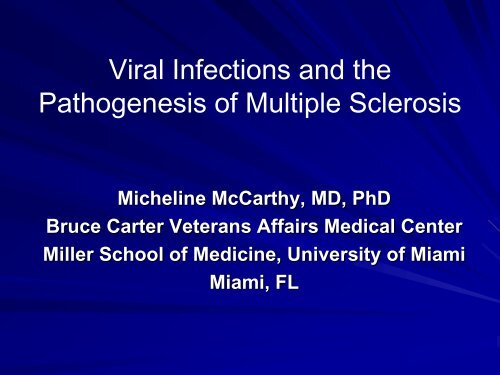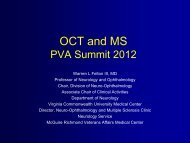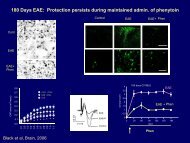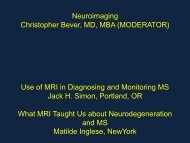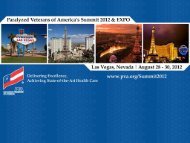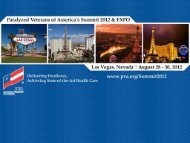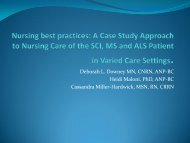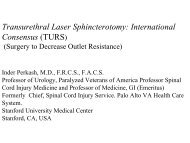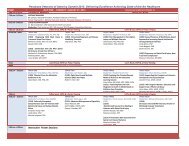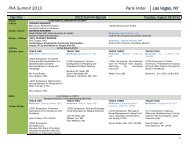Virus & MS
Virus & MS
Virus & MS
You also want an ePaper? Increase the reach of your titles
YUMPU automatically turns print PDFs into web optimized ePapers that Google loves.
Viral Infections and the<br />
Pathogenesis of Multiple Sclerosis<br />
Micheline McCarthy, MD, PhD<br />
Bruce Carter Veterans Affairs Medical Center<br />
Miller School of Medicine, University of Miami<br />
Miami, FL
<strong>MS</strong>: a disease with<br />
demyelination, axonal injury,<br />
white matter (and gray<br />
matter?) degeneration<br />
Epidemiology and<br />
pathogenesis of <strong>MS</strong>: Is <strong>MS</strong> a<br />
rare complication of a<br />
common microbe (e.g. virus)?<br />
If viruses are an environmental<br />
risk factor for <strong>MS</strong>, how can<br />
viruses contribute to<br />
pathogenesis of <strong>MS</strong>?
Pathogenetic Features of <strong>MS</strong><br />
What viral infections share these<br />
features?<br />
Inflammatory lesions in CNS<br />
Genetic susceptibility can occur<br />
Preponderance of CD8+ lymphocytes<br />
CSF Oligoclonal Bands<br />
Axonal Loss<br />
Gliopathy - Astrocyte and oligodendrocyte injury<br />
and death
Reported <strong>Virus</strong> Associations with<br />
Multiple Sclerosis<br />
<strong>Virus</strong><br />
– Rabies<br />
– Herpes Simplex type 2<br />
– Scrapie-like agent<br />
– Measles<br />
– Parainfluenza virus 1<br />
– SV5<br />
– Simian cytomegalovirus<br />
– Coronavirus<br />
– HTLV-1<br />
– Herpes Simplex type 1<br />
– HERV<br />
– HHV-6<br />
– Epstein-Barr virus<br />
Year<br />
– 1946<br />
– 1964<br />
– 1965<br />
– 1972<br />
– 1972<br />
– 1978<br />
– 1979<br />
– 1980<br />
– 1986<br />
– 1989<br />
– 1991/1994/1997<br />
– 1994/1995<br />
– 2000
Potential Links between Viral Infection<br />
and the Pathogenesis of <strong>MS</strong><br />
A variety of viruses may precipitate clinical<br />
<strong>MS</strong> attacks<br />
Epidemiology of <strong>MS</strong>: environmental<br />
exposure in childhood in genetically<br />
susceptible individuals<br />
Viral infection may be a co-factor<br />
interacting with the immune system<br />
• immune stimulation from viral antigens and<br />
viral infection<br />
• may be associated with persistent or reactivated<br />
viral infection
Potential Links between Viral Infection<br />
and the Pathogenesis of <strong>MS</strong><br />
<strong>Virus</strong> may cause cytopathic effect directly<br />
on oligodendrocyte (example – HHV-6<br />
infection)<br />
<strong>Virus</strong> may elicit cytotoxic immune<br />
response against virally-infected<br />
oligodendrocyte
Antibodies to <strong>Virus</strong>es:<br />
Is there a different pattern among <strong>MS</strong><br />
patients that implies a role for viruses?<br />
• Increased serum titers may occur:<br />
• measles,parainfluenza 3, influenza C,<br />
varicella, HSV, EBV (capsid, nuclear<br />
antigen), rubella (E2 glycoprotein), HTLV-<br />
1, HHV-6 (IgM)<br />
• Differentially elevated anti-viral antibody<br />
responses<br />
• Increased titers to Rubella E2 but not E1<br />
glycoprotein
Viral Infection as Immunological<br />
“Trigger” in <strong>MS</strong><br />
Activation of cellular immune responses in<br />
response to acute viral infection<br />
Stimulation of antigen-specific immune<br />
responses and programming of memory T-<br />
cells<br />
– Role of molecular mimicry and epitope spread
Theory of Molecular Mimicry<br />
Viral Ag with similar<br />
peptide sequence to<br />
a myelin Ag<br />
Stimulation of T cells<br />
specific for viral Ag<br />
Cross reaction with<br />
normal myelin Ag<br />
Local inflammatory<br />
and demyelinating<br />
reaction
Theory of Epitope Spread<br />
T cells specific for a<br />
single Ag (myelin or viral)<br />
Local inflammation and<br />
demyelination<br />
Activation of T cells<br />
specific for other myelin<br />
Ags<br />
Progressive inflammation<br />
and demyelination
Viral Infection as Immunological<br />
“Trigger” in <strong>MS</strong><br />
Response to viral infection fails to “shut down”<br />
Failure of adequate suppressor T-cell activity<br />
– Deficiency of suppressor-inducer T-cell<br />
subsets?<br />
– Viral infections (e.g. HIV-1) that can affect<br />
these subsets
Potential Links between Viral Infection<br />
and the Pathogenesis of <strong>MS</strong><br />
Viral infection may cause oligodendrogliopathy<br />
– Oligodendrocyte injury as the “first event”<br />
– Example: Papovavirus causes cytopathic infection of<br />
astrocytes and oligodendrocytes
Potential Links between Viral Infection<br />
and the Pathogenesis of <strong>MS</strong><br />
Abnormalities of the immune system may cause reactivation<br />
of latent viruses<br />
HHV-6
Human Herpesvirus-6 & <strong>MS</strong><br />
Lymphotropic beta herpesvirus (like CMV)<br />
– replicates productively in activated CD4+ T-cells,<br />
neural cells, endothelial cells, fibroblasts<br />
– May be capable of establishing a latent state<br />
– May invade the CNS directly<br />
Associated with childhood illness:<br />
– Roseola (exanthum subitum)<br />
– Febrile convulsions<br />
Cause of meningoencephalitis<br />
– transplant patients, other immunosuppressed<br />
– immune suppression alters virus infectivity and<br />
host susceptibility
Human Herpesvirus-6<br />
<strong>Virus</strong> infects oligodendrocytes and<br />
astrocytes<br />
Herpesvirus-6 infection of<br />
human astrocytes in cell<br />
culture
“Direct” Evidence for HHV-6 Infection<br />
Viral DNA or RNA sequences<br />
HHV-6 viral DNA in <strong>MS</strong> patient brains,<br />
including viral DNA in <strong>MS</strong> plaques<br />
HHV-6 viral DNA reported in patients’ sera<br />
and PBMC<br />
Is HHV-6 a “natural component” of CNS<br />
flora?
Anti-viral Antibodies<br />
Antibody Titers and HHV-6:<br />
Increased serum IgM but not IgG<br />
response to HHV-6 early antigen<br />
(p41/38) in RR<strong>MS</strong> compared to CP<strong>MS</strong>,<br />
OND, OID, controls<br />
Reflects viral persistence?<br />
Few studies detect viral antibody in CSF
Human Herpesvirus-6 & <strong>MS</strong><br />
Herpesviruses are associated with ubiquitous<br />
latent infections and frequent re-activations<br />
Does HHV-6 “active” infection in <strong>MS</strong> represent a<br />
symptom rather than a cause of <strong>MS</strong>?<br />
– <strong>MS</strong> could cause re-activation of HHV-6 from<br />
latent childhood infection<br />
Aggregate of HHV-6 studies not conclusive or<br />
consistent, but suggest a potential role for active<br />
HHV-6 in <strong>MS</strong> patients
Epstein-Barr <strong>Virus</strong> & <strong>MS</strong><br />
Herpesvirus associated with B-<br />
lymphotropic infection<br />
Infection of B-cells: can produce lytic<br />
infection or latency<br />
Potential for re-activation<br />
– Example: recurrent tonsillitis linked to<br />
recurrent EBV<br />
Infection in adolescence or adulthood:<br />
infectious mononucleosis (IM)
Epstein-Barr <strong>Virus</strong> & <strong>MS</strong><br />
Prior history of IM is risk factor for <strong>MS</strong><br />
– Relative Risk (RR) 2.17<br />
Meta-analysis of case control and cohort studies<br />
– EBV variant of hygiene hypothesis<br />
Prior history of IM increases risk of <strong>MS</strong><br />
associated with HLA-DRB1<br />
– DRB1 and IM 10-fold higher risk<br />
Risk of <strong>MS</strong> associates with higher anti-EBNA<br />
antibodies<br />
CIS patients also show higher anti-EBNA IgG
Epstein-Barr <strong>Virus</strong> & <strong>MS</strong><br />
EBV DNA in plasma detected in <strong>MS</strong> patients<br />
before onset (RR 2.5) – Nurses’ Health Study<br />
No association between quantitative EBV<br />
DNA load and <strong>MS</strong> risk<br />
<strong>MS</strong> patients have decreased CD8 T-cell<br />
responses to EBV-infected cells.<br />
– Studies using EBV-infected B-cell lymphoblastoid cell<br />
lines to measure T-cell responses<br />
– Decreased CD8 T-cell response could lead to<br />
accumulation of auto-reactive EBV-infected B-cells
Evidence: EBV infection and <strong>MS</strong> Risk<br />
Latitudinal gradient<br />
IM<br />
EBV serum Abs<br />
EBV DNA in CNS<br />
EBV specific T-cell<br />
responses<br />
+<br />
+++<br />
+++<br />
+<br />
++<br />
Lucas RM, Hughes AM, Lay MJ. 2011. JNNP 82:1142-1148.
Epstein-Barr <strong>Virus</strong> & <strong>MS</strong>- immunology<br />
EBV infects B-cells productive or latent infection<br />
1. EBV-specific T-cells or antibodies cross react with myelin antigens<br />
(molecular mimicry)<br />
Adapted from Lunemann et al<br />
J Virol 2007; 81:6777-6784.
Adapted from Lunemann et al<br />
J Virol 2007; 81:6777-6784.<br />
2. Latent EBV antigens in infected B-cells promote the survival of myelin-specific B-cells<br />
Does EBV initiate or perpetuate the <strong>MS</strong> disease process?
Adapted from Lunemann et al<br />
J Virol 2007; 81:6777-6784.<br />
3. EBV could stimulate other latent viruses (HERV)<br />
4. Activation of myelin-specific B cells promotes EBV replication and EBV-specific T- and<br />
B-cell responses (EBV is a epiphenomenon)<br />
Is EBV an epiphenomenon of a causative immune derangement?
<strong>Virus</strong>es and Pathogenesis of <strong>MS</strong>:<br />
Some Animal Models<br />
Theiler’s virus (Picornaviridae) of mice:<br />
associated genetic susceptibility of some strains of<br />
mice; persistent, restricted (non-productive)<br />
oligodendrocyte infection<br />
Mouse Hepatitis <strong>Virus</strong> (Coronaviridae): Viral<br />
strains vary in neurovirulence (viral glycoprotein S),<br />
genetic differences in antibody and cellular immune<br />
responses<br />
Semliki Forest <strong>Virus</strong> (Togaviridae):<br />
neuroinvasive and neurotropic virus; changes in<br />
blood-brain barrier, virus infects neurons and<br />
oligodendrocytes, secondary demyelinating immune<br />
response
Obtaining CME Credit<br />
• If you would like to receive CME credit<br />
for this activity, please visit:<br />
http://www.pesgce.com/PVAsummit2011/<br />
• This information can also be found in the Summit<br />
2011 Program on page 8.


